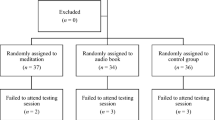Abstract
This study investigated the relation between an individual's tendency to tolerate and/or report discomfort and the amount of life change experienced by that individual. The role of attention in this relation was also examined and manipulated through instruction. Eighty college freshman were selected and divided into three groups (high, medium, low) as a function of scores obtained on the College Schedule of Recent Experience (CSRE). Participants were asked to experience two known discomforting stimuli, the cold pressor and loud broad-band noise. Dependent measures included participant's tolerance time, report of discomfort, and amount of attention paid to each of the stimuli. Results indicated that “high”-life change groups tolerated the two discomforting stimuli significantly less than either the “low”- or the “medium”-life change groups. Neither discomfort ratings nor attention was significantly different across groups. Findings are discussed in relation to epidemiological studies of the life change and illness relation.
Similar content being viewed by others
References
Costantini, A. F., Braun, J. R., Davis, J. E., and Iervolino, A. (1974). The Life Change Inventory: A device for quantifying psychological magnitude of changes experienced by college students.Psychol. Rep. 34: 991–1000.
Cox, T. (1978).Stress, Macmillan Press, London and Basingstoke.
Coyne, J. C., and Holroyd, K. (1982). Stress, coping and illness: A transactional perspective. In Millow, T., Green, C., and Meagher, R. (eds.),Handbook of Clinical Health Psychology, Plenum Press, New York.
Coyne, J. C., and Lazarus, R. S. (1980). Cognitive style, stress perception and coping. In Kutash, I. L., and Schlesinger, L. B. (eds.),Handbook on Stress and Anxiety: Contemporary Knowledge, Theory, and Treatment, Jossey-Bass, San Francisco.
Eysenck, H. J., and Eysenck, S. B. G. (1963).Manual for the Eysenck Personality Inventory, Educational & Industrial Testing Service, San Diego.
Glass, D. C., and Singer, J. E. (1972).Urban Stress: Experiments on Noise and Social Stressors, Academic Press, New York & London.
Grimm, L., and Kanfer, F. H. (1976). Tolerance of aversive stimulation.Behav. Ther. 7: 593–601.
Haney, C. A. (1977). Illness behavior and psychosocial correlates of cancer.Soc. Sci. Med. 11: 223–228.
Harrington, R. L., Burnell, G. M., and Korenoff, C. (1980). Systems approach to mental health care in a HMO model. Project Report, March 13, 1980, NIMH Grant MH 24109, Kaiser-Permanente Medical Office, San Jose, Calif.
Holmes, T. H., and Rahe, R. H. (1967). The social readjustment rating scale.J. Psychosom. Res. 11: 213–218.
Jenkins, C. D. (1979). Psychosocial modifiers of response to stress.J. Psychosom. Res. 5: 3–15.
Kalbfleisch, J. D., and Prentice, R. L. (1980).The Statistical Analysis of Failure Time Data, John Wiley & Sons, New York.
Kanfer, F. H., Cox, L. E., Greiner, J. M., and Karoly, P. (1974). Contracts, demand characteristics, and self-control.J. Personal. Soc. Psychol. 30: 605–619.
Lynn, R., and Eysenck, H. J. (1961). Tolerance for pain, extraversion and neuroticism.Percept. Motor Skills, 12: 161–162.
Marx, M., Garrity, T., and Bowers, F. (1975). The influence of recent life experience on the health of college freshmen.J. Psychosom. Res. 19: 87–98.
Mechanic, D. (1962). The concept of illness behavior.J. Chron. Dis. 15: 189–194.
Mechanic, D. (dy1976). Stress, illness, and illness behavior.J. Hum. Stress, 2–6.
Morgan, W. P., and Horstman, D. H. (1978). Psychometric correlates of pain perception.Percept. Motor Skills 47: 27–39.
Orne, M. T. (1962). On the social psychology of the psychological experiment: With particular reference to demand characteristics and their implications.Am. Psychol. 17: 776–783.
Rahe, R. H. (1978). Life change and illness studies: Past history and future directions.J. Hum. Stress 4: 3–15.
Rosenbaum, M. (1980). Individual differences in self-control behaviors and tolerance of painful stimulation.J. Abnorm. Psychol. 89: 581–590.
Shiomi, K. (1978). Relations of pain threshold and pain tolerance in cold water with scores on Maudsley Personality Inventory and Manifest Anxiety Scale.Percept. Motor Skills 47: 1155–1158.
Terenius, L., and Wahlstrom, A. (1978). Physiological and clinical relevance of endorphins. In Hughes, J. (ed.),Centrally Acting Peptides, University Park Press, Baltimore.
Tuke, D. H. (1872).Illustration of the Influence of the Mind upon the Body in Health and Disease, Designed to Elucidate the Action of the Imagination, Lindsay and Blakiston, Philadelphia.
Author information
Authors and Affiliations
Additional information
The present paper is a revision of a manuscript submitted by the first author in partial fulfillment of the requirement for the masters degree. The authors would like to thank Dr. Allan H. Marcus, Department of Pure and Applied Mathematics, for his statistical guidance and Mr. Mark Haller for his assistance in conducting the research. The research was supported in part by grants to the Self-Control Research and Training Unit, Department of Psychology, Washington State University, Pullman.
Rights and permissions
About this article
Cite this article
Harney, M.K., Brigham, T.A. Tolerance of aversive stimuli in relation to life change. J Behav Med 8, 21–35 (1985). https://doi.org/10.1007/BF00845510
Accepted:
Issue Date:
DOI: https://doi.org/10.1007/BF00845510




